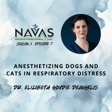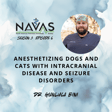
Understanding Anesthesia-Induced Hypotension with Dr. Vaidehi Paranjape - Ep. 12
Imagine you are anesthetizing your last patient of the day, and the alarm for the anesthesia machine is blaring, warning that your patient’s blood pressure is far too low. The machine reads 80/40 (55). It probably doesn’t seem too hard to imagine, because anesthesia-induced hypotension is one of the most common cardiovascular complications of general anesthesia.
In this episode, host Dr. Bonnie Gatson welcomes Dr. Vaidehi Paranjape. Not only is Dr. Paranjape a board-certified veterinary anesthesiologist and assistant professor at Virgina-Maryland College of Veterinary Medicine, but she has also focused her research career on understanding how to appropriately identify, measure, and manage cardiovascular problems under general anesthesia. We will answer your burning questions about blood pressure monitoring, including: what are we measuring when we take an animal’s blood pressure, how do we know if we are measuring blood pressure correctly, which is the most accurate indirect method of measuring blood pressure: oscillometric or Doppler, and what are the most appropriate steps to take when dealing with a hypotensive patient under anesthesia?
We invite our listeners to check out articles mentioned in today’s episode:
- 2020 AAHA Anesthesia and Monitoring Guidelines for Dogs and Cats
- ACVAA Recommendations for Anesthesia Monitoring in horses and small animals
- ACVIM consensus statement on the identification, evaluation, and management of systemic hypertension in dogs and cats
- Veterinary Blood Pressure Society
If you like what you hear, we have a couple of favors to ask of you:
Become a member at North American Veterinary Anesthesia Society (NAVAS) for access to more anesthesia and analgesia educational and RACE-approved CE content.
Spread the word. Share our podcast and FB/IG posts, re-tweet, post something on a network or a discussion forum, or tell a friend over lunch. That would really help us achieve our mission: Reduce mortality and morbidity in veterinary patients undergoing sedation, anesthesia, and analgesia through high-quality, peer-reviewed education.
We also ask our listeners to save the date for the NAVAS Virtual Spring Symposium on April 27th and 28th, 2024. For more information about the program, visit the NAVAS Spring Symposium website. Dr. Paranjape will be one of our featured speakers during the symposium, and several speakers will discuss blood pressure management under anesthesia.
Thank you to our sponsor, Dechra - learn more about the pharmaceutical products Dechra has to offer veterinary professionals, such as Zenalpha.
If you have questions about this episode or want to suggest topics for future episodes, reach out to the producers at education@mynavas.org.
All opinions stated by the host and their guests are theirs alone and do not represent the thoughts or opinions of any corporation, university, or other business or governmental entity.
The NAVAS Podcast is published monthly on or near the 15th of the month.
Special thanks to Chris Webster for editing, producer Maria Bridges, and Saul Jimenez for IT support in making this podcast a reality.











